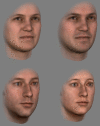Varying sex and identity of faces affects face categorization differently in humans and computational models
- PMID: 37752212
- PMCID: PMC10522766
- DOI: 10.1038/s41598-023-43169-9
Varying sex and identity of faces affects face categorization differently in humans and computational models
Abstract
Our faces display socially important sex and identity information. How perceptually independent are these facial characteristics? Here, we used a sex categorization task to investigate how changing faces in terms of either their sex or identity affects sex categorization of those faces, whether these manipulations affect sex categorization similarly when the original faces were personally familiar or unknown, and, whether computational models trained for sex classification respond similarly to human observers. Our results show that varying faces along either sex or identity dimension affects their sex categorization. When the sex was swapped (e.g., female faces became male looking, Experiment 1), sex categorization performance was different from that with the original unchanged faces, and significantly more so for people who were familiar with the original faces than those who were not. When the identity of the faces was manipulated by caricaturing or anti-caricaturing them (these manipulations either augment or diminish idiosyncratic facial information, Experiment 2), sex categorization performance to caricatured, original, and anti-caricatured faces increased in that order, independently of face familiarity. Moreover, our face manipulations showed different effects upon computational models trained for sex classification and elicited different patterns of responses in humans and computational models. These results not only support the notion that the sex and identity of faces are processed integratively by human observers but also demonstrate that computational models of face categorization may not capture key characteristics of human face categorization.
© 2023. The Author(s).
Conflict of interest statement
The authors declare no competing interests.
Figures






Similar articles
-
Personally familiar faces: Higher precision of memory for idiosyncratic than for categorical information.J Exp Psychol Learn Mem Cogn. 2020 Jul;46(7):1309-1327. doi: 10.1037/xlm0000784. Epub 2019 Nov 14. J Exp Psychol Learn Mem Cogn. 2020. PMID: 31724422
-
Distortions in the brain? ERP effects of caricaturing familiar and unfamiliar faces.Brain Res. 2008 Sep 4;1228:177-88. doi: 10.1016/j.brainres.2008.06.092. Epub 2008 Jul 2. Brain Res. 2008. PMID: 18634766 Clinical Trial.
-
Effects of Caricaturing in Shape or Color on Familiarity Decisions for Familiar and Unfamiliar Faces.PLoS One. 2016 Feb 22;11(2):e0149796. doi: 10.1371/journal.pone.0149796. eCollection 2016. PLoS One. 2016. PMID: 26900690 Free PMC article.
-
Discrimination and recognition of faces with changed configuration.Mem Cognit. 2020 Feb;48(2):287-298. doi: 10.3758/s13421-019-01010-7. Mem Cognit. 2020. PMID: 31939041
-
How much face identity information is required for face recognition?Cognition. 2025 Sep;262:106175. doi: 10.1016/j.cognition.2025.106175. Epub 2025 May 12. Cognition. 2025. PMID: 40359584
References
-
- Bruce V, Young A. Face Perception. Psychology Press; 2012.
-
- Calder AJ, Rhodes G, Johnson MH, Haxby JV, editors. Oxford Handbook of Face Perception. Oxford University Press; 2011.
MeSH terms
LinkOut - more resources
Full Text Sources

